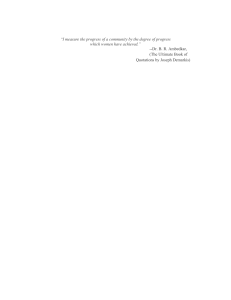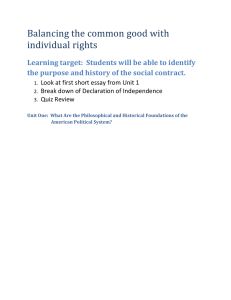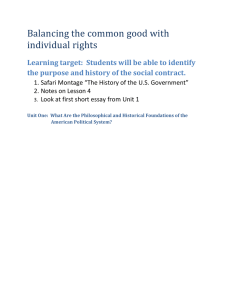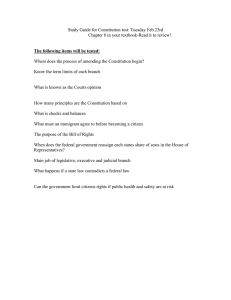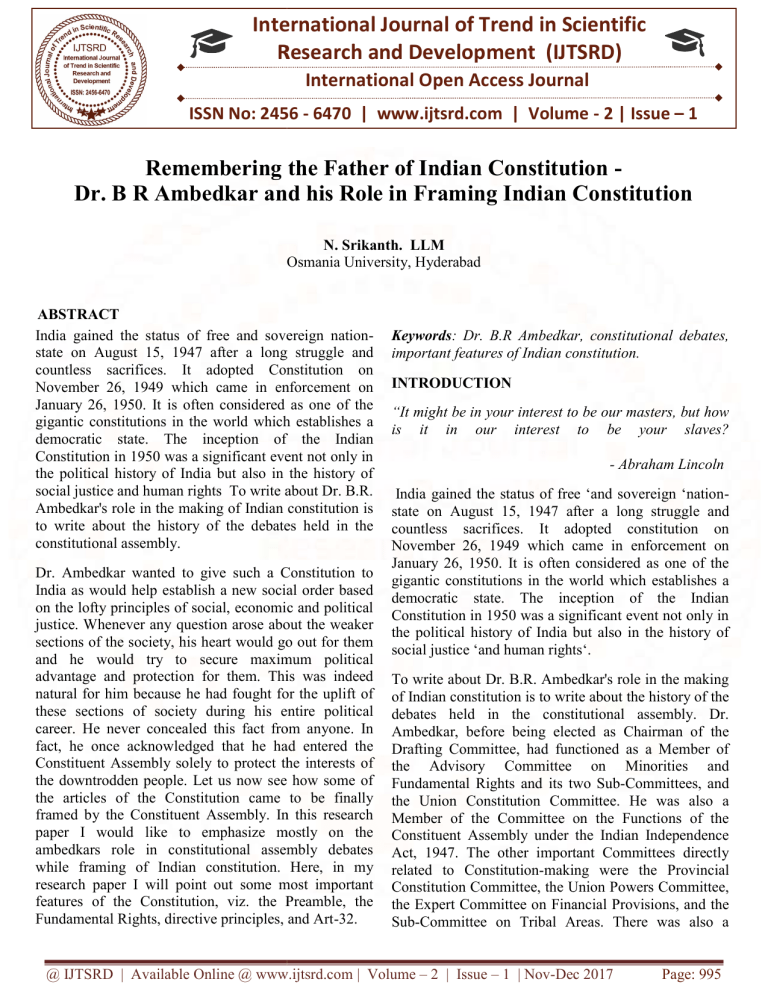
International Journal of Trend in Scientific
Research and Development (IJTSRD)
International Open Access
ss Journal
ISSN No: 2456 - 6470 | www.ijtsrd.com | Volume - 2 | Issue – 1
Remembering the Father of Indian Constitution Dr. B R Ambedkar and his Role in Framing Indian Constitution
N. Srikanth. LLM
Osmania University, Hyderabad
ABSTRACT
India gained the status of free and sovereign nation
nationstate on August 15, 1947 after
er a long struggle and
countless sacrifices. It adopted Constitution on
November 26, 1949 which came in enforcement on
January 26, 1950. It is often considered as one of the
gigantic constitutions in the world which establishes a
democratic state. The inception
ption of the Indian
Constitution in 1950 was a significant event not only in
the political history of India but also in the history of
social justice and human rights To write about Dr. B.R.
Ambedkar's role in the making of Indian constitution is
to write about the history of the debates held in the
constitutional assembly.
Dr. Ambedkar wanted to give such a Constitution to
India as would help establish a new social order based
on the lofty principles of social, economic and political
justice. Whenever any question arose about the weaker
sections of the society, his heart would go out for them
and he would try to secure maximum political
advantage and protection for them. This was indeed
natural for him because he had fought for the uplift of
these sections of society during his entire political
career. He never concealed this fact from anyone. In
fact, he once acknowledged that he had entered the
Constituent Assembly solely to protect the interests of
the downtrodden people. Let us now see how some of
the articles
rticles of the Constitution came to be finally
framed by the Constituent Assembly. In this research
paper I would like to emphasize mostly on the
ambedkars role in constitutional assembly debates
while framing of Indian constitution. Here, in my
research paper
aper I will point out some most important
features of the Constitution, viz. the Preamble, the
Fundamental Rights, directive principles, and Art
Art-32.
Keywords: Dr. B.R Ambedkar, constitutional debates,
important features of Indian constitution.
INTRODUCTION
“It might be in your interest to be our masters, but how
is it in our interest to be your slaves?
- Abraham Lincoln
India gained the status of free ‘and sovereign ‘nation‘nation
state on August
st 15, 1947 after a long struggle and
countless sacrifices. It adopted constitution on
November 26, 1949 which came in enforcement on
January 26, 1950. It is often considered as one of the
gigantic constitutions in the world which establishes a
democratic state. The inception of the Indian
Constitution in 1950 was a significant event not only in
the political history of India but also in the history of
social justice ‘and human rights‘.
To write about Dr. B.R. Ambedkar's role in the making
of Indian constitution
ution is to write about the history of the
debates held in the constitutional assembly. Dr.
Ambedkar, before being elected as Chairman of the
Drafting Committee, had functioned as a Member of
the Advisory Committee on Minorities and
Fundamental Rights and its two Sub-Committees,
Sub
and
the Union Constitution Committee. He was also a
Member of the Committee on the Functions of the
Constituent Assembly under the Indian Independence
Act, 1947. The other important Committees directly
related to Constitution-making
making were the Provincial
Constitution Committee, the Union Powers Committee,
the Expert Committee on Financial Provisions, and the
Sub-Committee
Committee on Tribal Areas. There was also a
@ IJTSRD | Available Online @ www.ijtsrd.com | Volume – 2 | Issue – 1 | Nov-Dec
Dec 2017
Page: 995
International Journal of Trend in Scientific Research and Development (IJTSRD) ISSN: 2456-6470
Commission on the question of creation of linguistic
provinces appointed on the recommendation of the
Drafting Committee. The reports of these several
Committees received Dr. Ambedkar's close scrutiny
and attention, both when they came for discussion in
the Constituent Assembly and in his capacity as
Chairman of the Drafting Committee.
The early life and education of Dr. B.R Ambedkar,
how he became a leader of untouchables
Before start about his early life it is very important to
know about the then social status of untouchables. Who
are the untouchables? They occupy the lowest rank of
the Hindu Caste system and thereby the fateful destiny
of being regarded as the “outcaste” by the top three
castes. They come to referred to as the untouchables
since their very touch-not just physical but “shadow
and even voice”-was considered polluting for caste
Hindus. Ambedkar’s biographer Dhananjay Keer
provides a vivid description of the social disabilities
forced on the untouchables by the Hindu caste system.
They were forbidden to keep certain animals, to use
certain metals for ornaments, were obliged to wear a
particular type of dress, to eat a particular type of food,
to use a particular type of footwear and were forced to
occupy the dirty, dingy and unhygienic outskirts of
villages and town for habitation where they lived in
dark, insanitary and miserably smoky shanties or
cottages. Since their very touch was polluting, they
were denied the use of public wells, often public roads
and their children were not allowed into public schools
for caste Hindu children. “These untouchable Hindus
were treated by the caste Hindus as sub-humans, less
than men, worse than beasts”.
In such a social climate of hatred, oppression and
exclusion, Ambedkar was born to a Mahar family
originally hailing from konkan. His ancestral village,
Ambavade was situated in the Ratnagiri district of
Maharastra in 1891. A Marathi, the local language,
proverb characterizes the mahar as eaters “of forbidden
food”.
Being born to a middle class family, Ambedkar was
educated in the local school and, in spite of suffuring
“life-defining humiliation” during his formative years,
went on to become the first college graduate in the
mahar community when he graduate from the
prestigious Elphinstone college in Bombay. His
incredible intellectual abilities and promise and
academics achievements earned him the financial
support from the Maharaja of Baroda, Sayyajirao
Gaikwa, for his stay at Columbia University where he
earned a PhD in Economics. Even urging his education
at Columbia this gifted and innovative son of Mahar
and india stayed focused on understanding the sociopolitical underpinnings of the caste system and
changing the plight of his community –the
untouchables who were marginalized in every aspect of
communal life.
In his very first speech in the Constituent Assembly on
December 17, 1946, much before he became Chairman
of the Drafting Committee, Dr. Ambedkar gave
expression to his firm faith in a united India.' (He was
participating in the debate on the historic Objectives
Resolution moved by Jawaharlal Nehru.) He said:
I have got not the slightest doubt in my mind as to the
future evolution and the ultimate shape of the social,
political and economic structure of this great country. I
know today we are divided politically, socially and
economically. We are a group of warring camps and I
may go even to the extent of confessing that I am
probably one 'of the leaders of such a camp. But, Sir,
with all this I am quite convinced that given time and
circumstances, nothing in the world will prevent this
country from becoming one: With all our castes and
creeds, I have not the slightest hesitation that we shall
in some form be a united people.
Dr. Ambedkar wanted to give such a Constitution to
India as would help establish a new social order based
on the lofty principles of social, economic and political
justice. Whenever any question arose about the weaker
sections of the society, his heart would go out for them
and he would try to secure maximum political
advantage and protection for them. This was indeed
natural for him because he had fought for the uplift of
these sections of society during his entire political
career. He never concealed this fact from anyone. In
fact, he once acknowledged that he had entered the
Constituent Assembly solely to protect the interests of
the downtrodden people when he said:
“I came into the Constituent Assembly with no greater
aspiration than to safeguard the interests of the
Scheduled Castes. I had not the remotest idea that I
would be ca lied upon to undertake more responsible
functions. I was, therefore, greatly surprised when the
Assembly elected me to the Drafting Committee. I was
more than surprised when the Drafting Committee
elected me to be its Chairman. There were in the
Drafting Committee men bigger, better and more
competent than myself such as my friend Sir Alladi
@ IJTSRD | Available Online @ www.ijtsrd.com | Volume – 2 | Issue – 1 | Nov-Dec 2017
Page: 996
International Journal of Trend in Scientific Research and Development (IJTSRD) ISSN: 2456-6470
Krishnaswami Ayyar. I am grateful to the Constituent
Assembly and the Drafting Committee for reposing in
me so much trust and confidence and to have chosen
me as their instrument and given me this opportunity of
serving the country”
At the same time, he had a sense of the limitations of
these three pillars of democracy and of the importance
of the role of citizen.
Constitution of drafting committee
The Constitution is a fundamental document. It is a
document which defines the position and power of the
three organs of the State-the executive, the .Judiciary
and the legislature. It also defines the powers of the
executive and the powers of the legislature as against
the citizens, as we have done in our chapter dealing
with Fundamental Rights. In fact, the purpose of a
Constitution is not merely to create the organs of the
State but to limit their authority, because, if no
limitation was Imposed upon the authority of the
organs, there will be complete tyranny and complete
oppression.
On 29 August 1947, the names of the Members of the
Drafting Committee were announced in the Constituent
Assembly. It was headed by Dr. B.R. Ambedkar and
included such legal luminaries as Alladi Krishnaswami
Ayyar, N. Gopalaswami Ayyangar, K.M. Munshl,
Saiyid Mohd. Saadulla, B.L. Mitter and D.P. Khaitan.
The
Drafting
Committee
was
subsequently
reconstituted when N. Madhava Rao was appointed to
replace B.L. Mitter, and T.T. Krishnamachan to fill the
vacancy caused by the death of D.P. Khaitan. In the
great task of the framing of the Constitution, Dr.
Ambedkar s association was close at all levels. He took
keen interest in the framing of the Rules of Procedure
of the Constituent Assembly which helped in
conducting its business on sound parliamentary
principles. The President and the other Members of the
Constituent Assembly looked to him for guidance
whenever there was any procedural wrangle or when
any Member had posed a difficult constitutional
conundrum which required immediate answer. The
Draft Constitution was introduced by Dr. Ambedkar for
the consideration of the Assembly on 4 November
1948. When this Draft was being debated in the
Assembly, Dr. Ambedkar, as the Chairman of the
Drafting Committee, had to answer many points raised
by the Members. Being a man of vast political
experience, he spoke with authority and was heard with
rapt attention by the Members of the Assembly. He
spoke elaborately on the various provisions made in the
Draft and on the various amendments moved by the
Members. He was always ready to answer points raised
by the Members.
Dr. Ambedkar had a clear perception of the mutuality
of the three pillars of State-the legislature, the
executive, and the judiciary. He realised that the
jurisdiction of each should be clear and untrammeled.
The following observation he made is significant:
Let us now see how some of the articles of the
Constitution came to be finally framed by the
Constituent Assembly. The following most important
features of the Constitution, i.e., the Fundamental
Rights, directive principles, and Art-32
Fundamental rights
The basic plan of the Fundamental Rights guaranteed in
the Constitution was prepared by the Advisory
Committee on Fundamental Rights. A number of
memoranda were submitted to this Committee by
eminent Members like K.M. Munshi, K.T. Shah and
others, but the Fundamental Rights, as finally adopted
by the Constituent Assembly, are far more proximate to
the suggestions of Dr. Ambedkar than to the
suggestions of any other Member of the Assembly.
A close look at Art. II Sec. I of his Memorandum" and
the Constitution reveals that, of the 19 articles dealing
with the Fundamental Rights, as many as 15 articles
can be traced to the suggestions put forward by Dr.
Ambedkar. To make the position clear, here is a
comparative statement:
@ IJTSRD | Available Online @ www.ijtsrd.com | Volume – 2 | Issue – 1 | Nov-Dec 2017
Page: 997
International Journal of Trend in Scientific Research and Development (IJTSRD) ISSN: 2456-6470
Sr
No
Subject
Article of the
Constitution
1
2
3
4
5
6
Equality before law
Prohibition of discrimination
Equality of opportunity
Abolition of untouchability
Right to freedom
Protection in respect of conviction for Offences
14
15
16
17
19
20
Clauses of Articles II
sec.1 of the
memorandum
3
4&5
6
1
7&12
13
7
8
9
Protection of life and personal liberty
Protection against arrest and detention
Prohibition of traffic in human beings and Force labour
21
22
23
2
2
9
10
Prohibition of employment of children in factories
24
9
11
Freedom of consciences and free Profession, Practice and
25
14
propagation of religion
12
Freedom to manage religious affairs 18&19
26
13
Freedom as to payment any taxes for Promotion of any
27
20
28
15
32
21 and CI(1) of sec. II
particular religion
14
Freedom as to attendance at religious Instruction or religious
worship in certain Educational institutions
15
Remedies for enforcement of fundamental Rights
The remaining four articles which did not find place in
Dr. Ambedkar's Memorandum relate to: Abolition of
titles (Art. 18); Cultural and educational rights of
minorities (Arts. 29 and 30); and Right to property (Art.
31).
The Discussion on the Fundamental Rights began in the
Constituent Assembly on 25th November 1948.
Replying to the critics of the wide definition of the
word 'State' used in draft Art. 7, which later became
Art. 12 of the Constitution, Dr. Ambedkar emphasized
the two-fold objectives of the Fundamental Rights and
their universal application.
The object of the Fundamental Rights is two-fold. First,
that every citizen must be in a position to claim those
rights. Secondly, they must be binding upon every
authority-I shall presently explain what the word
"authority" means--upon every authority which has got
either the power to make laws or the power to have
discretion vested in it. Therefore, it is quite clear that if
the Fundamental Right. are to be clear, then they must
be binding not only upon the Central Government, they
must not only be binding upon the Provincial
Government, they must not only be binding upon the
governments established in the Indian states, they must
also be binding upon district local boards ,
Municipalities , even village panchayats and taluka
boards, in fact, every authority which has been created
by law and which has got certain power to make laws,
to make rules, or make by-laws’
Draft Art. 13 guaranteeing the seven freedoms were as
follows :( 1) Subject to the other provisions of this
article: all citizens shall have the right:
a.
b.
c.
d.
e.
to freedom of speech and expression
to assemble peaceably and without arms
to form associations or unions
to move freely throughout the territory of India
to reside and settle in any part of the territory of
India
f. to acquire, hold and dispose of property; and
g. to practice any profession, or to carry on any
occupation, trade or business.
@ IJTSRD | Available Online @ www.ijtsrd.com | Volume – 2 | Issue – 1 | Nov-Dec 2017
Page: 998
International Journal of Trend in Scientific Research and Development (IJTSRD) ISSN: 2456-6470
These were not an absolute rights, it was followed by
certain restrictions. Under Draft article 13(1-6) When
the Draft Constitution was circulated for public
opinion, the provisions relating to this article received,
By far, the most critical comments from some sections
of the society. Fully conscious of the importance of
these provisions, Dr. Ambedkar, while introducing the
Draft Constitution on 4 November 1948, replied to the
critics in these words
The most criticized part of Draft Constitution is that
which relates to fundamental rights. It is said that
Article 13' which defines fundamental rights is riddled
with so many exceptions that the exceptions have eaten
up the rights altogether. It is condemned as a kind of
deception. In the opinion of the critics fundamental
rights are not fundamental rights unless they are also
absolute rights. The critics rely on the Constitution of
the United States and on the Bill of Rights embodied in
the first ten Amendments to that Constitution in support
of their contention. It is said that the fundamental rights
in the American Bill of Rights are real because they are
not subjected to limitations or exceptions. I am sorry to
say that the whole of the criticism about fundamental
rights is based upon a misconception. In the first place,
the criticism in so far as it seeks to distinguish
fundamental rights from non-fundamental rights is not
sound. It is incorrect to say that fundamental rights are
absolute while non-fundamental rights are not
absolute. The real distinction between the two is that no
fundamental rights are created by agreement between
parties while fundamental rights are the gift of the law.
Because fundamental rights are the gift of the State, it
does not follow that the State cannot qualify them.
When this article came up for discussion in the
Assembly, over a hundred amendments were proposed.
Of these, only three were accepted by Dr. Ambedkar.
Directive principle of state polices
If Chapter Three of the Constitution on Fundamental
Rights provides for the political and civil rights of
individuals, Chapter Four enshrines Directive
Principles of State Policy which deal with the concept
of socio-economic justice. Directive Principles, which
are given in the Constitution immediately after the
Fundamental Rights, 10 fact, complement the latter.
They aim at directing the State to ensure social and
economic justice to individuals. Needless to say, the
Directive Principles present a novel feature of the
Indian Constitution.The only other Constitution of a
parliamentary democracy which embodies these
principles is that of Ireland. The Directive Principles
were criticized by Members of the Constituent
Assembly. They described them as "only pious
declarations having no binding force". All this criticism
was found to be superfluous by Dr. Ambedkar because
the Constitution itself had declared them to have no
binding force. Answering the charge Dr. Ambedkar
said:
If it is said that the Directive Principles have no legal
force behind them, I am prepared to admit it. But I am
not prepared to admit that they have no sort of binding
force at all. Nor am I prepared to concede that they are
useless because they have no binding force .The
Directive Principles are like the Instrument of
Instructions which were issued to the GovernorGeneral and to the Governors of the Colonies and to
those of India by the British Government under the
1935 Act. Under the Draft Constitution it is proposed to
Issue such instruments to the President and to the
Governors. The texts of these Instruments of
Instructions will be found in Schedule IV of the
Constitution. What is called Directive Principles is
merely another name for Instruments of Instructions.
The only difference is that they are instructions to the
Legislature and the Executive. Such a thing is to my
mind to be welcomed. Wherever there is a grant of
power in general terms for peace, order and good
government, it is necessary that it should be
accompanied by instructions regulating its exercise.
Inclusion of Directive Principles in the Constitution
was further justified by Dr. Ambedkar on the ground
that being a democratic country, in India it would be
the people who would be electing their Government.
Whoever came to power would not be free to do what
he liked because of the existence of Directive
.Principles. In the exercise of power he would be
respecting these Instruments of Instructions. While a
Government might not have to answer for the breach of
the Directive Principles in a Court of Law, it certainly
would have to answer for them before the electorate
during the elections.
Article 32
The Fundamental Rights enshrined in the Constitution
of India have been made justifiable. Article 32(2)
states: "the Supreme Court shall have power to issue
directions or orders or writs, including writs in the
shape of habeas corpus, mandamus, prohibition, quo
warranto and certiorari whichever may be appropriate,
for the enforcement of any of the rights 'conferred by
@ IJTSRD | Available Online @ www.ijtsrd.com | Volume – 2 | Issue – 1 | Nov-Dec 2017
Page: 999
International Journal of Trend in Scientific Research and Development (IJTSRD) ISSN: 2456-6470
this Part". The provision of this constitutional remedy,
which follows almost hterally the provision suggested
by Dr. Ambedkar in Cl. (1) of Sec. II, Art. II of his
Memorandum is the most effective guarantee for
enforcing the Fundamental Rights. But for this
provision, the insertion of Fundamental Rights in the
Constitution would have been meaningless as rights are
real only if they are accompanied by remedies. Dr.
Ambedkar described the importance of Art. 32 in these
terms on the floor of the House:
I am very glad that the majority of those who spoke on
this article have realized the importance and
significance of this article. If I was asked to name any
particular article in this Constitution as the most
important-an article without which this Constitution
would be a nullity
I could not refer to any other article except this one. It
is the very soul of the Constitution and the very heart of
it and I am glad that the House has realized its
importance.
On 17 November 1949, the Constituent Assembly
began the third reading of the Constitution Bill. Dr.
Ambedkar replied to the nine-day debate in the
afternoon of 25 November 1949. Speaking with a
feeling of great relief, he gave a graphic picture of the
work done by the Drafting Committee and the
Assembly. He also thanked the Assembly for having
given him an opportunity for serving the county. Then
Dr. Ambedkar turned his thoughts to the future of the
country and expressed his anxiety in these words:
Here I could have ended. But my mind is so full of the
future of our' country that I feel I ought to. Take this
occasion to give expression to some of my reflections
thereon. On 26 January 1950, India will be an
independent country. What would happen to her,
independence will she maintain her independence or
will she lose it again? This is the first thought that
comes to my mind. It is not that India was never an
independent country. The point is that she once lost the
independence she had. Will she lose it a second time? It
is this thought which makes me most anxious for the
‘future. What perturbs me greatly' is the fact that not
only India has once before lost her independence but
she lost it by the infidelity and treachery of some of her
own people. In the invasion of Sind by Mohammed-BinKasim, the military commanders of King Dahar
accepted bribes from the agents of Mohammed-BinKasimand refused to fight on the side of their King. It
was Jaichand who invited Mahommed Gohri to invade
India and fight against Prithvi Raj and promised him
the help of himself and the Solanki Kings. When Shivaji
was fighting for the liberation of Hindus, the other
Maratha noblemen and the Rajput Kings were fighting
the battle on the side of Moghul Emperors. When the
British were trying to destroy the Sikh Rulers, Gulab
Singh, their principal commander, sat silent and did not
help to save the Sikh kingdom. .Will history repeats
itself? It is this thought which fills me with anxiety. This
anxiety is deepened by the realization of the fact that in
addition to our old, enemies in the form of castes and
creeds we are going to have many political parties with
diverse and opposing political creeds. Will Indians
place the country above their creed or will they place
creed above country? I do not know. But this much is
certain that if the parties place creed above country,
our independence will be put in jeopardy a second time
and probably is lost forever. This eventuality we must
all resolutely guard against. We must be determined to
defend our independence with the last drop of our
blood.
He further said:
On 26 January 1950, India would be a democratic
country in the sense that India from that day would
have a "government of the people, by the people and for
the people". The same thought comes to my mind. What
would happen to her democratic Constitution? Will she
be able to maintain it or will she lose it again? This is
the second thought that comes to my mind and makes
me as anxious as the first.
Conclusion
To produce the Constitution, with its 395 articles and 8
schedules, the Constituent Assembly sat for 165 days in
11 sessions, out of which 114 days, spread over five
sessions, were devoted to the finalization of the Draft
Constitution introduced by Dr. Ambedkar on 4
November 1948. The proceedings of the last five
sessions of the Constituent Assembly are printed in five
volumes (Vol. VII-Xl) and cover more than 4600pages.
How minutely the Draft Constitution was scrutinized
by the Members of the Assembly is evident from the
large number of amendments to which they had given
notice. As many as 7,635 amendments were tabled and
2,473 were actually moved in the House, the rest being
withdrawn after some discussion. A study of the
voluminous debates reveals that Dr. Ambedkar, the
chief architect of the Constitution, was closely
questioned on each and every provision being made in
the Constitution, and he was always found ready to
answer all sorts of doubts and quires of the Members.
Though a good number of the amendments moved by
@ IJTSRD | Available Online @ www.ijtsrd.com | Volume – 2 | Issue – 1 | Nov-Dec 2017
Page: 1000
International Journal of Trend in Scientific Research and Development (IJTSRD) ISSN: 2456-6470
the Members were accepted by the Constituent
Assembly, no amendment was accepted by the House
unless it was acceptable to Dr. Ambedkar. Dr. Rajendra
Prasad, President of the Constituent Assembly, paid
glowing tributes to Dr. Ambedkar for his zeal and
devotion in helping the Assembly to accomplish the
Herculean task of framing a worthy Constitution for
free India's governance.
In Dr. Rajendra Prasad's own words:
Sitting in the Chair and watching the proceedings from
day to day, I have realized as nobody else could have,
with what zeal and devotion the members of the
Drafting Committee, and especially its Chairman, Dr.
Ambedkar, in spite of his indifferent health, have
walked. We would never make a decision which was or
could be ever so right as when we put him on the
Drafting Committee and made him its Chairman. He
has not only justified his selection but has added luster
to the work which he has done.
References
1) Anil Bharadwaj (2002) Welfare of Scheduled
Castes in India: Gandhi’s Social Approach;
Ambaedkar’s Political Approach; Constitutional
Safeguards and Schemes for Welfare of Scheduled
Castes, New Delhi: Deep & Deep. Publication.
2) Dr B R Ambedkar: The Messiah
Downtrodden Hardcover – 1 Jan 2010
of
the
a. By Janak Singh , Kalpaz Publications (1
January 2010)
3) Constitutional Assembly Debate, 17 December
1946, p. 100.
4) CAD, 4 November 1948, p. 44.
5) CAD, 17 October 1949, pp. 455-456.
6) CAD, 25 November 1948, p. 610.
7) CAD, 4 November 1948, p. 40.
8) CAD, 9 December 1948, p. 953.
9) CAD, 25 November 1949, pp. 977-978.
10) Ibid. pp. 980-981.
11) CAD, 26 November 1949, p. 995.
12) Ibid. p. 994. CAD, 17 December 1946, p. 100.
@ IJTSRD | Available Online @ www.ijtsrd.com | Volume – 2 | Issue – 1 | Nov-Dec 2017
Page: 1001


